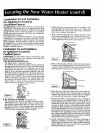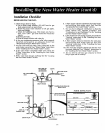
Combustion Air and Ventilation
for Appliances Located in
UnconfinedSpaces
UnconfinedSpaceisa spacewhose volume isnot lessthan 50
cubicfeet.per 1,000 .B.tu.perhourof theaggregate inputrating
of all appliancesinstalledinthat space.Roomscommunicating
directlywith the space in which the appliances are installed,
through openingsnot furnished with doors, are considereda
part ofthe unconfinedspace
In unconfinedspacesin buildings, infiltrationmay be adequate
toprovide air for combustion,ventilation and dilution of flue
gases.However, in buildings of tight construction(forexample,
weatherstripping,heavily insulated,caulked, vapor barrier,
etc.),additional air may needto be provided usingthe methods
described in Combustion Air and Ventilation for Appliances
LocatedinConfined Spaces,b.
Combustion Air and Ventilation
for Appliances Located in
Confined Spaces
Confined Spaceis a spacewhose volume is lessthan 50 cubic
feet per 1,000 Btu per hour of the aggregateinput rating of all
appliancesinstalled in that space.
a. ALLAIRFROM INSIDE BUILDINGS:
(SeePage8 Figure 1,and Figure2 below)
The confined space shall be provided with two permanent
openingscommunicating directly with an additional room(s)
of sufficient volume so that the combined volume of all
spacesmeets the criteria for an unconfined space. Thetotal
input of all gas utilization equipment installed in the com-
bined space s.hallbe considered in making th s determina-
tion. Each opening shall have a minimum free area of one
squareinch per 1,000 BTU per hour of the total input rating
of all gas utilization equipment in the confined spade, but
not less than 100 square inches. One opening shall com-
mence within 12 inches of the top and one commencing
within 12 inchesof the bottom of the enclosure.
,-_i..:,::. i..
b. ALL,AIRFROM OUTDOORS: (see Figures3-5)
The confined space shall be provided with two perma-
nent openings, one commencing within 12 inches of the
top and Onecommencing within 12 inches from the bot-
tom of the enclosure. The openings shall communicate
directly, or by ducts, with the outdoors or spaces (crawl or
attic) that freely communicate with the outdoors.
_qrulloH LOUW_
1. When directly communicating with the outdoors, each
opening shall have a minimum free area of 1 square inch
per 4,000 BTU per hour of total input rating of all equip-
ment in the enclosure. (SeeFigure 3.)
2. When communicating with the outdoors through vertical
ducts, each opening shall have a minimum free area of 1
square inch per 4,000 BTU per hour of total input rating
of all equipment in the enclosure. (SeeFigure4.)
CHIMNEY OR GAS VENT
VENTUL.TION LOUVERS
AIR OUTLET
WATER HEATER
FURNACE
INLET AIR DUCT
I l (e_ 1' abo_ _c_)
Figure 4
3. When communicating with the outdoors through horizon-
tal ducts, each opening shall have a minimum free area of
1 square inch per 2,000 BTU per hour of total input rating
of all equipment in the enclosure. (SeeFigure5.)
I Figure 5 [
4.
,
,
=_
_- .: R
When ducts are used, they shall be of the samecross-sec-
tional area as the free area of the openings to which they
connect. The minimum short side dimension of rectangular
air ducts shall not be lessthan 3 inches. (SeeFigure5.)
Louversand Grilles:In calculating free area, consideration
shall be given to the blocking effect of louvers, grilles or
screens protecting openings. Screens used shal| not be
smaller than 1/4inclhmesh. If the free area througha design
of louver or grille is known, it should be used in calculat-
ing the size opening required to provide the freearea spec-
ified. If the design and free area is not known, it may be
assumedthat wood louvers will be 20-25 percent free area
and metal louvers and grilles will have 60-75 percent free
area. Louversand grilles shall be fixed in the open position
or interlocked with the equipment so that they are opened
automatically during equipment operation.
Special Conditions Created by Mechanical Exhausting or
Fireplaces:Operation of exhaust fans, ventilation systems,
clothes dryers or fireplaces may create conditions requiring
special attention to avoid unsatisfactory operation of
installed gas utilization equipment.


















